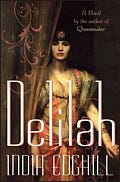Readers familiar with the tale of Samson and Delilah will find new twists in India Edghill's retelling of the Biblical story (in Judges 13-16). Samson was the Israelite warrior who slew a thousand Philistines with the jawbone of an ass and destroyed their crops by setting the tails of three hundred foxes afire and turning them loose in Philistine fields and vineyards. He fell for Delilah, a seductive beauty who discovered the secret of his unusual strength and cut his hair as he slept so her people could enslave him. When his hair grew back, he destroyed a Philistine temple and the worshipers within by toppling its supporting pillars.
Edghill's sympathetic Delilah is a priestess of the goddess Atargatis and a supremely talented dancer. Temple ceremonies and the dress of the priestesses are lavishly described: "Curled and knotted hair, painted face and gilded breasts, cinched bodice and seven-tiered skirt, scarlet girdle and anklets hung with silver bells – unless I moved, I could be taken for a statue, an icon rather than a living woman." The novel lingers on Delilah's childhood and her close friendship with a fellow priestess, beautiful Aylah, whose shining blonde hair contrasts with her heart-sister's night-dark hair.
Samson, too, has sun-colored hair. His birth was considered miraculous, and his parents brought him up according to the strict religious precepts of the Nazirites, who abstained from alcohol and haircuts. Unlike the Biblical Samson, Edghill's hero is a pacifistic soul who keeps a tame lion and steadfastly refuses to lead a gang of hotheads (the "Foxes") who claim to be his followers.
Delilah paints a respectful portrait of Philistine culture and religion, though the evolving monotheism of its Israelite hero is subtly preferred. The novel can at times be repetitious in making its points, but the vivid scenes of life in the temple of Atargatis (perhaps just one of many guises through which people experience God's grace?) have considerable charm. (2009; 354 pages, including an Afterword discussing the Biblical and historical underpinnings of the story)




